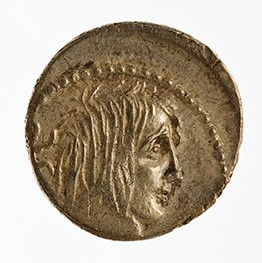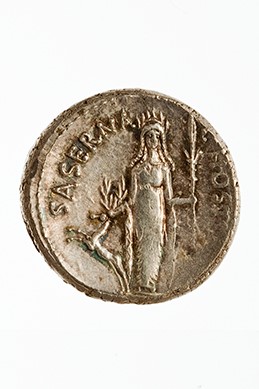Acquisition number: 1966.79
Obv.: Female head r., with long hair dishevelled. Behind, a carnyx (Gallic trumpet). Border of dots.
Rev.: Diana draped standing front, spear in left hand and right hand on prancing stag. On right, L(ucius) HOSTI[LIVS] (downwards); on left, SASERNA (upwards). Border of dots.
Title: Denarius of L. Hostilius Saserna - 1966.79
Acquisition number: 1966.79
Author or editor: Beryl Rawson
Culture or period: Roman Republic
Date: 48 BC
Material: Metal - Silver
Object type: Coins - Roman
Dimensions: 18mm (w)
Origin region or location: Italy
Origin city: Rome
Display case or on loan: 5
Keywords: Coin, denarius, Roman, Republic, Diana
Sear, D.R., Roman Coins and their Values 5 vols (London, Spink, 2000-2014) 419;Crawford, M., Roman Republican Coinage 2 vols (Cambridge, Cambridge University Press, 2011) 448/3 and pl. LIII.9; Sydenham, E. A. The Coinage of the Roman Republic (London, Spink, 1952; (Sanford J. Durst repr. 1976) 953; Seaby, H.A., Roman Silver Coins (London, B.A. Seaby, 1967) Hostilia 4; Sear, D.R., The History and Coinage of the Roman Imperators (London, Spink, 1998) 19; Grueber, H.A., Coins of the Roman Republic in the British Museum 3 vols (London, The Trustees of the British Museum, 1910; rev. edn London, 1970) I. 3996.
1966.79
Denarius of L. Hostilius Saserna
3.877 g. 48 BC
Obv.: Female head r., with long hair dishevelled. Behind, a carnyx (Gallic trumpet). Border of dots.
Rev.: Diana draped standing front, spear in left hand and right hand on prancing stag. On right, L(ucius) HOSTI[LIVS] (downwards); on left, SASERNA (upwards). Border of dots.
There were three Hostilii brothers, all supporters of Julius Caesar. The types here refer to Caesar’s victories in Gaul. The head on the obverse is that of a Gallic captive. There was an important cult of Artemis/Diana at Massilia (Marseille) (Strabo 179).
The coin was minted at Rome as Caesarian propaganda in the civil war. Caesar’s victories in Gaul in the fifties had enhanced his military reputation, and in 49 BC he captured Massilia. In 48 BC he crossed to Greece, where he defeated Pompey at Pharsalus.
Sear, D.R., Roman Coins and their Values 5 vols (London, Spink, 2000-2014) 419;Crawford, M., Roman Republican Coinage 2 vols (Cambridge, Cambridge University Press, 2011) 448/3 and pl. LIII.9; Sydenham, E. A. The Coinage of the Roman Republic (London, Spink, 1952; (Sanford J. Durst repr. 1976) 953; Seaby, H.A., Roman Silver Coins (London, B.A. Seaby, 1967) Hostilia 4; Sear, D.R., The History and Coinage of the Roman Imperators (London, Spink, 1998) 19; Grueber, H.A., Coins of the Roman Republic in the British Museum 3 vols (London, The Trustees of the British Museum, 1910; rev. edn London, 1970) I. 3996.

